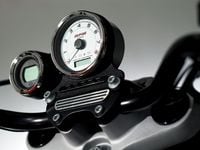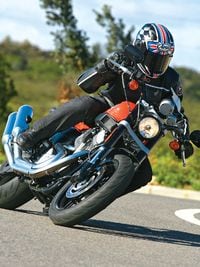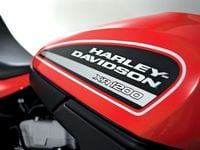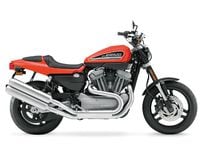What took so long, and when can I buy one?" That was the overwhelming response to the October 2006 debut of Harley-Davidson's XR1200 prototype, a street-legal tribute to the iconic XR750s that have dominated American dirt-track racing for more than three decades. The XR1200 has finally reached production, complete with Willie G's brilliant, flat track-inspired styling, a surprisingly effective chassis honed by none other than nine-time AMA Grand National Champion Scott Parker and a satisfying powerplant that delivers a claimed 91 horsepower-20 up on the standard XL1200 Sportster. Just one problem: You can only buy the XR1200 in Europe, Africa or the Middle East-American enthusiasts need not apply.
How ironic that this American motorcycle, inspired by the most American form of motorcycle racing, isn't available on the American market. This discrepancy reflects shifting realities inside Harley-Davidson. A plunging exchange rate, combined with a significant dip in home-market sales (down 18.1 percent since '06), has made the export market (up 29.9 percent over the same period) more important to Harley than ever before. The result? Bikes developed exclusively for Europe that aren't available in America-at least for the time being.
That's too bad, because the XR1200 is an impressive streetbike. As an expression of The Motor Company's confidence, the new machine was introduced on the hardcore racer roads just inland from Spain's Valencia Grand Prix circuit. Riding H-D's Orange Blossom Special through the orange groves in the company of Parker and other hard-riding members of Harley's R&D; team demonstrated that the XR delivers the goods.
The XR utilizes a more potent version of Harley's iconic Evolution V-twin, rubber-mounted in the standard Sportster frame. The super-Sportster motor still transmits quite a bit of vibration at rest, persisting through the footpegs until 2500 rpm, after which it smoothes out. From there to the hard, 7000-rpm rev limit it's all muscle, delivering a linear build of power with zero driveline snatch to make for a forgiving and easy rider.
Low-end vibes are a bit of a pain around town, but in the happy zone between 3000 and 6500 rpm you can't help but feel you belong at the Springfield Mile. The XR is satisfyingly fast and torquey to ride hard, with the well-mapped fuel injection delivering good midrange response and respectable top-end performance, pulling an indicated 200 kph (124 mph) in top gear. A sixth ratio would give it slightly longer legs, but that's not really practical on a naked bike.
Back at idle, you'd never guess this is essentially the same engine that's fitted to the rest of the Sportster range. It emits much less mechanical noise than the Nightster, with fewer rattles and a more responsive throttle pickup. And thanks to the XR's exclusive oil-cooling system-necessary to address the higher-spec engine's higher operating temperatures-the engine also looks neater, without so many external oil lines.
The XR sounds better than other Sportsters too, thanks to H-D's clever Active Intake System that quiets the motor at (coincidentally, we're sure) the exact same rpm and road speeds that EU noise tests are carried out. This system allows Harley to run a less restrictive setup outside of these parameters, which not only enhances performance but also allows a bike that still sounds great through the twin, stacked, stainless steel 2-1-2 exhaust on the right side of the bike.
Chuck a leg over the low, narrow seat and everything feels right, with the wide, tapered-section handlebar pulled back to deliver an upright but still sporty stance-although we wouldn't want the footpegs any farther back. Semi-aggressive ergos are appropriate here, as Harley has never made a Sportster that steers so well. In spite of its 551-pound dry weight and pronounced 54-percent rearward weight bias the XR handles brilliantly, even by such benchmark standards as the Aprilia Tuono or KTM Superduke. It steers very precisely, if a little heavily-you have to use the wide handlebar to lever it from side to side in a succession of turns. But the long, 59.6-inch wheelbase delivers excellent high-speed and mid-corner stability without sacrificing feedback from the front tire.
Speaking of which, the sportbike-spec Dunlop D209 Qualifiers developed specifically for this model provide plenty of grip and secure cornering. "We tried different-sized tires, but settled on the 18-inch front as giving the most assured handling," said project leader Jim Graham, explaining the unusual (nowadays) front wheel size. "The 17-incher commonly found on sportbikes made it overly responsive and not easily controlled by the average rider."
The non-adjustable Showa 43mm inverted fork and preload-adjustable twin shocks were a big surprise, offering unexpected compliance and good ride quality. The shock springs look to be variable-rate but aren't; the fact that the XR doesn't skip and hop over bumps suggests that H-D's calibration staff spent ample time optimizing valving and damping.
Though seemingly small for such a heavy bike, the four-piston, 292mm front brakes are so responsive that it generally requires no more than a single finger to produce hard stops. Amazing-good brakes on a Harley Sportster! Thanks to the conservative steering geometry, you can trail-brake deep into bends without any sense that the front wheel will tuck in, nor will the bike try to sit up if you grab a little more while leaned over. The Harley seemed satisfyingly stable under hard braking, without any need for a steering damper, even when you meet a bump cranked over in a fast sweeper.
After a long day spent duking it out with the Parker posse along Spain's finest racer roads, my only question remained the same as 18 months ago: What took Harley so long to build a proper XR750 replica? And why did it take the persuasive power of the European importers to finally convince Milwaukee management to make a Harley that handles? Better late than never, I guess-unless you live and ride in the USA!
Tech Spec
Evolution
The stalwart XL1200 Sportster updated with a hot-rodded engine, sportier suspension, better brakes and stylish new skin inspired by the iconic XR750 flat-tracker.
Rivals
Air-cooled sporty standards like Buell's XB12S, Ducati's GT1000 and Hypermotard, Moto Guzzi's Griso 8V and Triumph's Thruxton.
Contact
Harley-Davidson Motor Company
3700 W. Juneau Ave.
Milwaukee, WI 53208
414.343.4056
Verdict
The best "starter" Harley yet, with power and handling that finally live up to the Sportster name. Bring this bike to America-and soon!
2008 Harley-Davidson XR1200
Hard Parts - A Closer Look At The Hot-Rod Hog
Engine
Harley's engineering staff made many mods to bring the Sportster's venerable air-cooled, pushrod V-twin up to XR spec. A larger crankpin (1.5 inches, compared to the standard XL1200's 1.25 in.) fitted with a racing-quality roller bearing beefs up the bottom end, and a higher-flow oil pump is now driven off the cam to reduce "social noise." Bore and stroke remain unchanged at 88.9 x 96.8 mm, as does valve train geometry and valve diameters, but a new cam similar to that of the Buell XB provides a power boost. Redline has been increased 1000 revs to 7000 rpm and compression rises from 9.7:1 to 10:1. Oil-cooled cylinder heads appear for the first time to better control temperature (especially exhaust-valve temps), with a small oil cooler mounted to the frame downtube. A Delphi-made ECU controls the sequential-port fuel injection that features a larger, 50mm Dell'Orto twin-throat throttle body (up from the XL's 45mm). The intake has been reconfigured to a downdraft arrangement, compared to the sidedraft format of the standard Sportster, and the traditional side-mounted air cleaner has been replaced by an under-tank airbox. H-D's Active Intake System makes an appearance here, utilizing a solenoid-activated flapper to cancel resonance at certain rpm to reduce noise. The five-speed transmission is unchanged, though the primary drive ratio has been raised from 1.50 to 1.68 for snappier acceleration.
Chassis
The XR's double-cradle frame is essentially identical to that of the XL except for slightly sportier steering geometry to sharpen handling. The steering head angle is 29.3 degrees; a 1.5-degree reduction in rake engineered into the triple clamps grants an effective 27.8 degrees of rake. A long, 59.6-inch wheelbase and generous 5.1 inches of trail ensure steering stability without sacrificing too much response. An attractive cast-aluminum swingarm anchors the rear end, acting on twin shocks that are adjustable for spring preload only. Up front is an aggressive-looking 43mm inverted fork that offers no adjustment, but is plenty stiff from the factory for spirited street riding.
Wheels And Brakes
Lightweight, six-spoke cast-aluminum wheels carry grippy, sport-compound Dunlop D209 Qualifier tires. The rear is 180mm wide, the front 120mm, in a somewhat unusual 18-inch diameter-a 17-inch front wheel apparently didn't agree with the rangy front-end geometry. Brakes are among the best ever fitted to a Harley, consisting of twin four-piston Nissin calipers and 292mm Sunmax discs up front, with a two-piston caliper and 260mm disc slowing the rear wheel.
Body Work
The sharp-looking fuel tank faithfully recreates the shape of the XR750 racebikes. Unfortunately, the miniscule, 3.5-gallon capacity will have you seeing the low-fuel light in as few as 75 miles if you ride aggressively, resulting in a range more suited to the racetrack than the open road. An air scoop under the right tank flank routes fresh air into the airbox. The one-piece tailsection resembles an oversized version of the racebike's cowling, and incorporates a passable passenger pad suitable for short jaunts. Like the racebike it's meant to emulate, the XR1200 should be considered a solo conveyance.


















/cloudfront-us-east-1.images.arcpublishing.com/octane/TNOU5DNE2BC57MFPMGN2EIDXAM.jpg)
/cloudfront-us-east-1.images.arcpublishing.com/octane/GTCXACQGJ5HAPDTGWUQKDEH44E.jpg)
/cloudfront-us-east-1.images.arcpublishing.com/octane/S35YGSEMEZB4BLTDJTSZPF4GLA.jpg)
/cloudfront-us-east-1.images.arcpublishing.com/octane/5UOT6HPX2JFMRJAX6EH45AR4MQ.jpg)
/cloudfront-us-east-1.images.arcpublishing.com/octane/OKWOJWAKP5EP3OACCRRWPCIX2Q.jpg)
/cloudfront-us-east-1.images.arcpublishing.com/octane/2WF3SCE3NFBQXLDNJM7KMXA45E.jpg)
/cloudfront-us-east-1.images.arcpublishing.com/octane/G4MG6OUCJNBSHIS2MVVOTPX65E.jpg)
/cloudfront-us-east-1.images.arcpublishing.com/octane/IIGGWFOTOJGB7DB6DGBXCCMTDY.jpg)
/cloudfront-us-east-1.images.arcpublishing.com/octane/QSTCM6AVEZA5JJBUXNIQ3DSOF4.jpg)
/cloudfront-us-east-1.images.arcpublishing.com/octane/U4I7G625B5DMLF2DVIJDFZVV6M.jpg)
/cloudfront-us-east-1.images.arcpublishing.com/octane/B6XD6LS6IVCQPIU6HXDJSM3FHY.jpg)
/cloudfront-us-east-1.images.arcpublishing.com/octane/ICL63FEDDRDTTMINYICCEYGMDA.jpg)
/cloudfront-us-east-1.images.arcpublishing.com/octane/FCGZHQXRBZFLBAPC5SDIQLVF4I.jpg)
/cloudfront-us-east-1.images.arcpublishing.com/octane/WNOB6LDOIFFHJKPSVIWDYUGOPM.jpg)

/cloudfront-us-east-1.images.arcpublishing.com/octane/X33NU3E525ECRHXLNUJN2FTRKI.jpg)
/cloudfront-us-east-1.images.arcpublishing.com/octane/6KKT5NNL2JAVBOXMZYS5ZO76YA.jpg)
/cloudfront-us-east-1.images.arcpublishing.com/octane/J5RKG5O455GMPGQRF2OG6LRT7A.jpg)
/cloudfront-us-east-1.images.arcpublishing.com/octane/GX2CIZKQVRH2TATDM26KFG2DAE.jpg)
/cloudfront-us-east-1.images.arcpublishing.com/octane/ZWIDYSAKQZHD5BHREMQILXJCGM.jpg)
/cloudfront-us-east-1.images.arcpublishing.com/octane/CYUHJZCTSJCH3MRAQEIKXK7SCQ.jpg)
/cloudfront-us-east-1.images.arcpublishing.com/octane/LKOFINY56FCXJCANJ5M7ZDQUBY.jpg)
/cloudfront-us-east-1.images.arcpublishing.com/octane/4NBPDACMWJH63JQYJVK3QRBDZI.jpg)
/cloudfront-us-east-1.images.arcpublishing.com/octane/KKHQHRR3FJGX7H2IPU6RALMWG4.jpg)